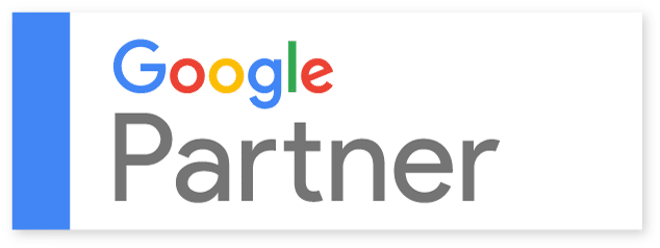How Social Media has Transformed Journalism | JSB Talks Digital Podcast
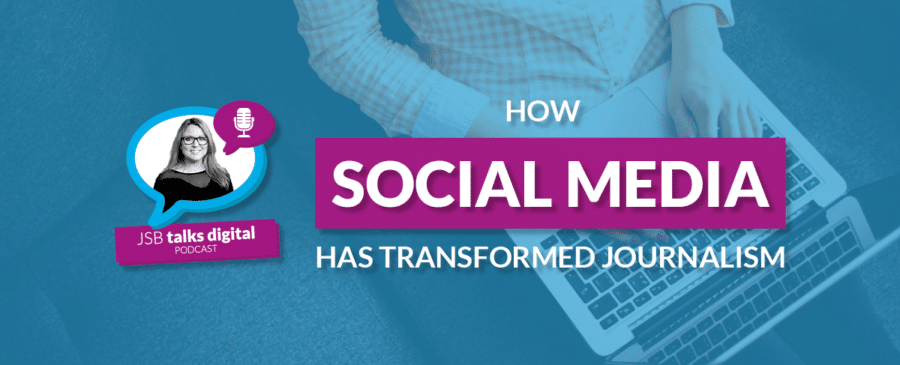
JSB Talks Digital is a weekly digital marketing and social media podcast hosted by author, strategist, consultant, speaker and trainer Joanne Sweeney-Burke. Each Friday Joanne shares her digital marketing and social media insights from her work as CEO of Digital Training Institute.
In this episode, I explore how social media has transformed journalism. As a former journalist and broadcaster, I can see a significant shift in this industry and I thought I’d explore it more in today’s show.
Coming up in the podcast:
- It’s all about Facebook in social media news:
- I updated my Facebook App and I noticed a second News Feed;
- Great news for online educators with units added to Groups; and
- Facebook updates its Clickbait algorithm.
- I interview Heather Conley, Former US Deputy Assistant Secretary of State and now Senior Vice President and Director of Europe Program at the Center for Strategic and International Studies, Washington. Heather and I discuss how social media is acting as a filter for politicians from mainstream media.
- In shout-outs: a political, policing and a public policy case study of how to amplify news using social media;
- Ask JSB – journalists ask me my opinions about social news;
- In JSB’s column – How social media has transformed the journalism landscape and why the profession needs to upskill before they are left behind;
- Find out what social media tool will make your week if you are monitoring breaking news.
Social Media News
It’s all about Facebook in this week’s social media news
I updated my Facebook App last week and I noticed a second News Feed indicated by a ‘rocket’ icon. Have a look at the blog post associated with this podcast to see how it looks on my smartphone.
I’ve been asking my social media peers about it and I’ve discovered most don’t have it, so it‘s in beta testing.
Some peeps in the US and Ireland did have it but said it disappeared. Others have a video icon which I don’t have. But I’ve noticed that live videos of brands that I’m following have appeared automatically in the bottom right-hand corner of my News Feed – another new development.
I really like the second News Feed which contains trending news and viral stories.
I’m a news hound and so I have found myself jumping in there much more than on my own News Feed, which still is a curation of friends and brand updates.
So with less and less space for Facebook to publish all the content created by its 2 billion users, it seems they are seeking innovative ways to deal with the issue which of course gives it another advertising stream.
I haven’t seen any advertising in the rocket timeline quite just yet, but Facebook is always looking for more ad inventory.
**********
Great news for online educators with units added to Groups
I’m an e-learner and I also sell online courses so the news that Facebook is rolling out ‘Units’ to Groups is most welcome.
Did you know the eLearning market is growing at an unprecedented rate? eLearning revenues have exceeded $50 billion. Also interesting to note is that 78 percent of organizations reportedly use a Learning Management System (LMS).
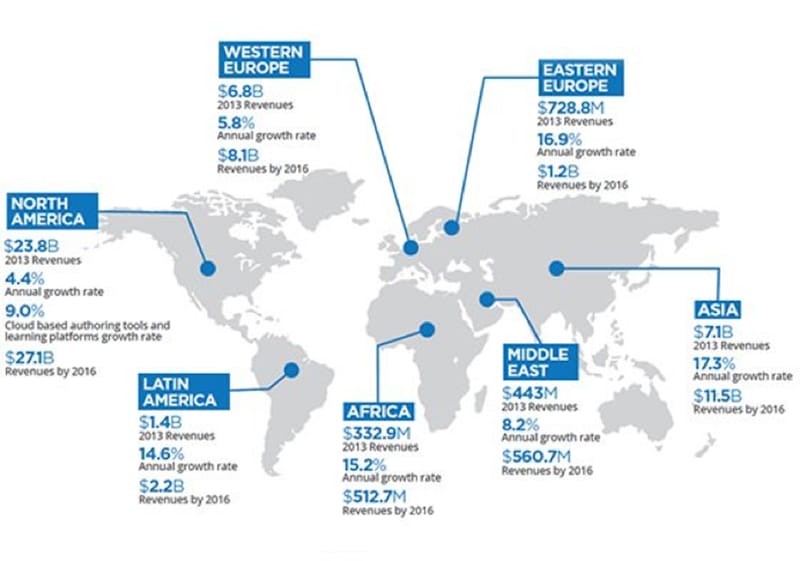
You can add “Units” to Facebook Groups: currently it’s only available in Groups set to “School or Class” type.
You can create multiple Units, add new content, and/or retroactively add previous wall posts to Units.
Group members see a progress bar as they go through Units and are rewarded upon completion. So Facebook is modelling this on typical LMS platforms.
I’ve posted a screen-grab shared by Marie Smith of her www.innercirclewithmari.com Facebook Group.
What do you think, will you use the units tab to sell eLearning products?
**********
Facebook updates its Clickbait algorithm
Following their move to combat Fake News by taking out full page ads in UK newspapers, Facebook has reportedly also made another update to its algorithm to combat clickbait.
Clickbait is a technique used mainly by websites which sell advertising, so for example, media sites to drive more traffic.
Headlines are written deliberately to make you click to find out more, but which are usually exaggerated. But Facebook wants to clamp down on it!
Facebook’s method for determining whether something is clickbait works a lot like the spam filter in your email – it’s programmed to look for key words and phrases that typically indicate whether content falls in that category, then flags that content accordingly.
There are two specific types of clickbait that Facebook targets: headlines that leave out crucial information, and ones that mislead and exaggerate.
As I always say, if you want to go fast, break the rules but it you want to go far, stick to the rules so by clickbaiting you might win more traffic to your website but it will be short-lived because the algorithm will eventually close the door to the reach of your posts!
Interview | Heather Conley, Former US Deputy Assistant Secretary of State
 In today’s show I interview Heather Conley, Former US Deputy Assistant Secretary of State. She’s now Senior Vice President and Director of Europe Program at the Center for Strategic and International Studies, Washington.
In today’s show I interview Heather Conley, Former US Deputy Assistant Secretary of State. She’s now Senior Vice President and Director of Europe Program at the Center for Strategic and International Studies, Washington.
Heather and I discuss how social media is acting as a filter for politicians from mainstream media.
Tune in to the podcast to hear our discussion.
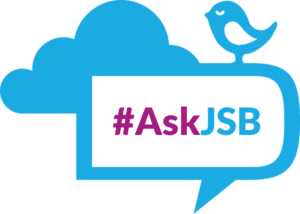 Ask JSB
Ask JSB
Ask JSB brings the voices of my listeners onto the show. So you now have an opportunity to ask me a question, have it aired on the podcast and I will respond.
If you want to hear your voice on JSB Talks Digital simply log on to digitaltraining.ie/askjsb and you might find yourself and your question on air!
In today’s show, journalists ask me my opinions about social news.
Q1: Chris McNulty, Donegal Sports Hub
How do you think the life cycle of a news story has evolved with social media? And how do you think journalists and news outlets should be leveraging that transformation?
Q2: John Lynch, Head of Sport Shannonside/Northern Sound
How can I use social media to maximise the biggest possible audience for live sports broadcast?
Shout-Outs: Three examples of social news reporting
Shout-outs to brands, organisations or individuals whose work online is remarkable and worth talking about.
In this week’s show I’m giving a nod to three great examples of how to amplify news with social media. In line with my work on Digital Transformation in the Public Sector I’m looking at policing, politics and public policy case studies. But we can all learn from them in the private sector.
1. How social media reported the London Attacks
On Saturday night June 3rd 2017, a BBC News update on Facebook announced a serious incident at London Bridge. Very quickly it emerged on Twitter that this was yet another terrorist attack.
Real-time news is exactly that. From citizen journalists on the scene capturing photos, videos and even doing reportage, we are taken to the scenes of breaking news via social networks.
We now know The Met Police responded and reacted, and their responsiveness resulted in the three attackers being shot dead within 8 minutes. A remarkable feat for any police force.
What followed was advice however from their Twitter account to Run, Hide and Tell.
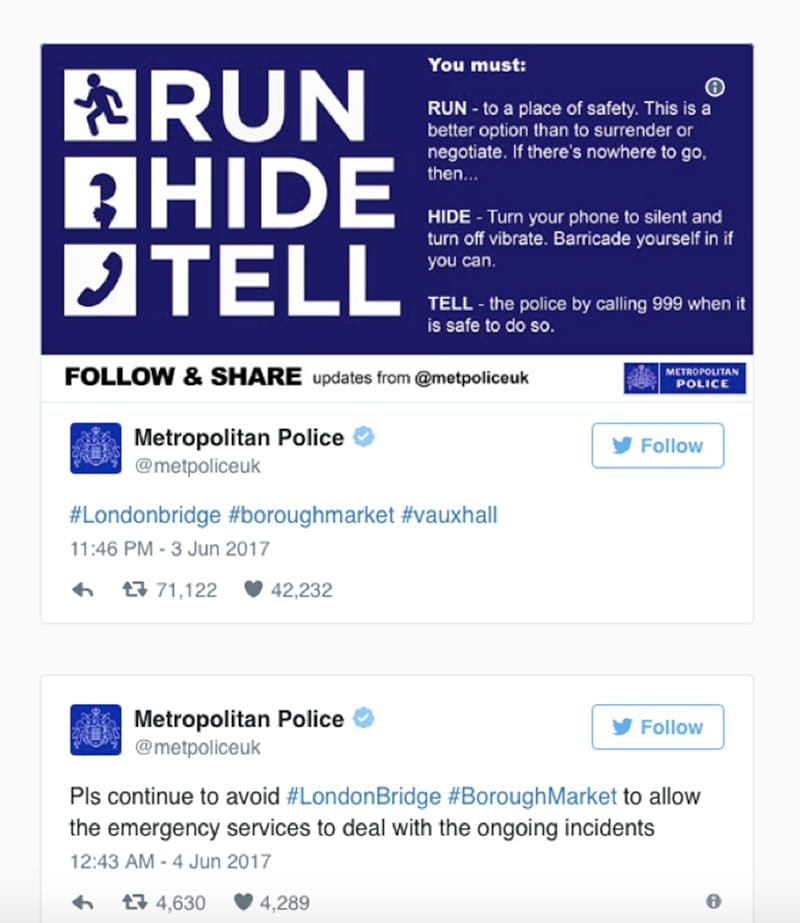
They also used Twitter to ask Londoners to avoid London Bridge and Borough Market and used those locations as hashtags also for greater visibility.
A quick analysis of the hashtag #londonbridge showed in 12 minutes 100 Tweets were sent by 89 people resulting in over half a million impressions and reaching 438,000 Twitter accounts.
In the days that followed video footage emerged from onlookers. In one Tweet on June 4th we see police surrounding a man who appears to be wielding a knife.
The Tweeter is Battle Beagle who says:
London Police Have Everything Under Control??
You’ve Got Nothing to Worry About!?#LondonBridgeAttack #London #londonattack #AltRight pic.twitter.com/3c9xm8Bgz2— Battle Beagle (@HarmlessYardDog) June 4, 2017
2) HSE Cyber Attack
The Irish Health Service was the victim of a recent Cyber Attack, which affected 16 health service organisations in England and Scotland.
Pictures posted on social media showed screens of NHS computers with images demanding payment of $300 worth of the online currency Bitcoin, threatening to delete files within seven days.
The HSE launched a social media campaign and used Twitter as their core communications channel. They launched a dedicated crisis hashtag #thinkB4Uclick and within 48 hours it has reached over 1 million impressions and reached 6380,000 Twitter accounts.
They also developed a ‘how to’ guide for its 107,000 staff on what to do when they came into work on Monday as the attack presented itself on Friday evening.
This graphic was featured widely on online media sites giving the campaign greater visibility and authority on search engines.

CIO of the HSE Richard Corbridge said that social media had been an invaluable communications tool as all email in the HSE had been shut down for 4 days.
3) Fine Gael Leadership Race
The recent Fine Gael leadership race which ultimately would decide the next Taoiseach of Ireland was a brilliant example of social media PR.
Four regional hustings were held where both candidates, Minister Leo Varadkar and Minister Simon Coveney, went head-to-head in a live debate.
I signed up for reminders and notifications on Facebook for all four events, which were moderated by Gavin Duffy an independent chair, so the party decided not to have a practicing journalist moderate.
While the audiences in each of the four regional locations were made up of Fine Gael members we are Irish citizens were able to watch and contribute though Facebook comments.
The mainstream media reported using the Facebook Live broadcasts including the final results, which were also broadcast live in a stream hosted by a Fine Gael Deputy. It all resembled a professional media TV station but in fact it was a political party controlling the news and leveraging that to dominate mainstream news.
JSB’s Column | How social media has transformed the journalism landscape and why the profession needs to upskill before they are left behind

In today’s column, I’m exploring how the world of journalism has been transformed by social media. When I began working as a paid broadcast journalist in 2001 I was updating the station website but that’s as far as our news sharing went. It was either on-air content or on the website. I guess we were early adopters in terms of having twice daily news updates on the website.
But fast-forward 16 years and the sector has been transformed.
Journalism suffered like every industry in the recession. Budgets were cut, there was no investment in upskilling, the core focus was to sell on-air advertising to fund salaries. All the while the Digital Revolution was exploding underneath reporters’ notebooks!
Reuters News Agency recently carried out a survey which said that 78% of people right now prefer to read long-form content. That research would seem to be in direct conflict with the research of social networks and technology companies which deem video the transformer of the Internet by 2020.
So news isn’t dead, nor will it ever be. However, 2016 was the year of the echo chambers and the escalation of fake news sites. In an interview with Dr. David Stanilov from the Transatlantic Academy in Germany on episode #39 I was shocked to learn that right now, for every 1 journalist in the US there are 4 PR consultants.
Now I’m not dissing PR consultants, hell I am one! But the balance of news output has been reduced and so what we read on the social web is dominated by non-news sources.
The Reuters Institute for the Study of Journalism research suggests 51% of people with online access use social media as a news source. Social media also ‘outstrips TV’ as news source for young people. Of the 18-to-24-year-olds surveyed, 28% cited social media as their main news source, compared with 24% for TV.
The report, now in its fifth year, is based on a YouGov survey of about 50,000 people across 26 countries, including 2,000 Britons.
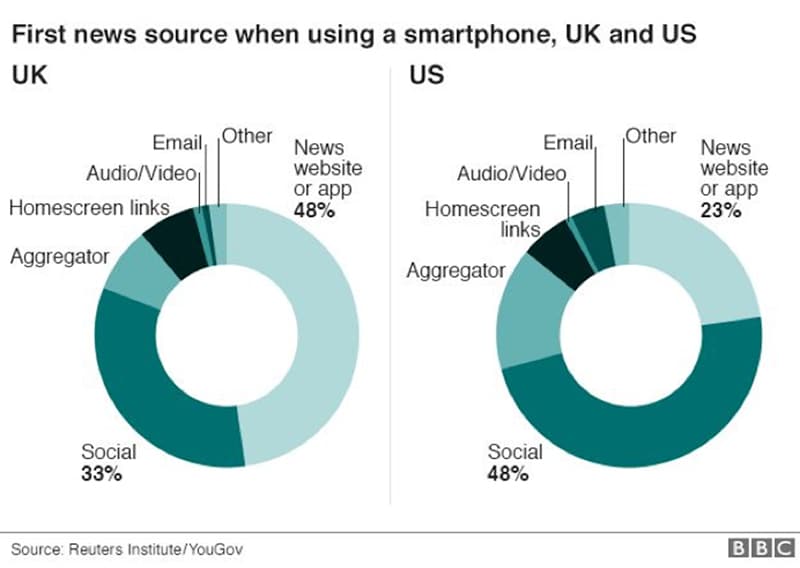
Meanwhile, Farhad Manjoo in the New York Times says Twitter is a haven for fake news. He maintains that the micro-blogging site actually helps news manipulators.
“If you can get something big on Twitter, you’re almost guaranteed coverage everywhere.”
Manjoo says Twitter is clogged with fake people:
“When journalists see a story getting big on Twitter, they consider it a kind of responsibility to cover it, even if the story may be an alternate frame or a conspiracy theory,” said Alice Marwick, who was co-author of a recent report on the mechanics of media manipulation for the Data & Society Research Institute. “That’s because if they don’t, they may get accused of bias.”
We’ve seen how President Donald Trump’s Tweets are now making mainstream news, even his ‘covfefe’ typo Tweet went viral and dominated news stories.
So where is journalism in all of this?
The role of journalism has never been so vital. The media have a responsibility to counter-act fake news, to understand how the Internet works and even to upskill in terms of optimizing news.
Journalists are natural storytellers, they understand how to engage an audience, they are proficient writers and exceptional narrative creators – they are just missing one vital piece – digital skills. With greater investment in career journalists who missed the boat into the Digital Age we can try and re-capture truth so vital in a world where terrorism, hate speech and trolling dominate our news feeds.
Social Media Tool of the Week: Zenark
The tool that saved my working week this week is Zenark.
If you are engaged in online PR campaigns or content outreach then you should ask yourself, ‘how much time am I spending each day reading through online news sites?’
Zenark provides its clients with news, information, and opinion from every key online source that impacts their business or organization.
I am able to track keywords relating to my business and my clients so that I don’t miss an online media mention, and I get twice daily updates at 8am and 3pm collating all mentions so far that day.
I also monitor for subjects I’m interested in for example, policing and social media and politics and social media.
With critical information collected and delivered to me by email twice-daily I can identify threats or opportunities and act immediately and effectively while saving hours of manual research.
This is now I keep on top of news stories which are evolving hourly in the digital age.
If you are looking for an Electric Search product which is cost effective in terms of tracking and monitoring breaking news stories available in the UK or Ireland today log onto Zenark.com for more.
I love feedback
I’d love to know what you think about this episode. So please get in touch by commenting below or tweet me @tweetsbyJSB or send me a snap to jsbsnaps.
Listen: JSB Talks Digital | Episode #51
I would like to thank Eoghan Murphy aka The Galway Gamer for producing my podcast series and to Flirt FM on the campus of NUI, Galway where I am based for the use of their studio.







